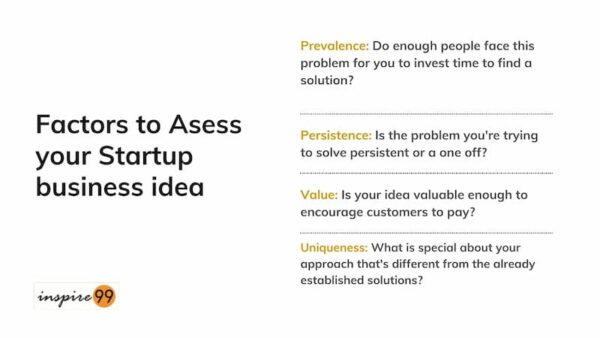Idea into Business: What does it take to turn an idea into a startup? In this article, we talk about the steps to identify, assess and build your idea into a plan. Once you have a strategy or plan, the ideal route is to raise funds and start creating foundations for your business.
We will discuss the following steps in this article:
- How to identify if your idea is good?
- Developing a business framework around your idea
- Creating plans, strategy and prototypes etc.
Ultimately, this article will point you to move from an idea into a viable proposal.
How to turn your idea into business?

There’s usually a huge difference between an initial idea to an actual business. When you have an idea – your first step is to identify whether it is viable to convert into a startup. (Related: How to check the viability of your business model)One of the most common reasons for startup failure is the ability to achieve a product market fit. This means that your idea fails to attract a sufficient number of end users. Hence, it is very important to spend time assessing the quality and potential of your idea.
- Assess – to identify if the idea has potential
- Validate – Customer interest sign up, letter of interest etc
- Prototype – Minimum Viable product, seed funding etc
- Develop – to build grow and develop business model
How to assess a startup idea?

Not every idea can be a startup. A great idea usually follows the pattern of
- Prevalence: Is the problem you’re solving prevalent i.e do enough people face this problem for you to invest time to find a solution
- Persistence: Does this challenge occur frequently i.e we are trying to assess if your idea solves a continuous problem or one off. A consistent issue is considered more valuable from an investor’s point of view
- Value: Is your idea valuable enough that people will be willing to pay for your product?
- Uniqueness: What makes your idea special compared to others in the market? This helps us identify whether a competitor can easily win over your idea
These concepts can help you identify the quality of an idea and whether it is worth investing your time.
Validate your idea
Once you know that your idea is good enough – you need to find out if it makes sense to others too. Every innovator believes that their idea is amazing and solves a massive problem. The only way to know is to talk to people and find out.
We’re still at an idea stage here, no need to have the final product too. All you’re trying to find out is if a solution is valuable. Does it seem like a good problem to invest your time in solving. You don’t need a product at this stage. All you’re trying to find out is if it makes sense to people. Remember that not all feedback is valuable. This exercise helps you gather feedback and in some cases even influence a change in your idea.
Develop the idea into business plan
Arguably, this is the toughest part of growing an idea into a business. Thankfully, there are some templates to help you bring this idea to life. The end goal of this stage is to create a sensible strategy. You can use this business plan to help raise some pre-seed funding for your startup. The pre-seed funding is a stage where you can raise money to develop an initial prototype of your solution.
The quickest way to get to a strategy is by creating a business model canvas. The canvas helps you map out your business idea into a startup. It elevates your thinking from an idea stage into a company. The business model canvas will challenge your thinking in terms of suppliers, competitors and value etc to help you think about a startup pitch.
Use the business model canvas as a base to start developing your idea. All standard business plans have the same common terminology and headings. A plan/startup pitch gives your investor a clear idea about your idea, strategy and approach to developing into a sensible company. You can use this to go for initial fund-raise and sometimes even competitions that offer you seed funding.
Create a Minimum Viable product or prototype
All complex products need either a prototype or minimum viable product. The concept of Minium viable product is very powerful in the context of tech solutions which require huge upfront investment. In these cases, you can use the pre-seed fund to develop initial versions of a product.
The best way to use an MVP or prototype is to hire your early adopters. Use this MVP to identify how many people would sign up for your solution. You can use this as proof of interest or validation for your business approach. This can act as powerful data when you talk to investors during seed stage of your startup.
In addition, you can try to recruit early adopters for your solution. The beauty of a good early adopter is that they act as a sign of approval for your idea and hypothesis. They may convert into a user customer later on as you develop further. But investors and future customers will love the idea of Developed with X as an early adopter when you go out for subsequent conversations

Pingback: How to Become a Startup Entrepreneur? - Inspire99
Pingback: Pros and cons of being an entrepreneur - Inspire99
Pingback: 5 Practical tips for a startup business - Inspire99
Pingback: The Startup Hockey Curve for Exponential Growth - Inspire99
Pingback: If you’re starting something new, you better have the passion! - Inspire99
Pingback: 3 Types of Exit Strategy for a startup founder - Inspire99
Pingback: Training The skill of self confidence in a Startup Context - Inspire99
Pingback: The world isn't going to shower gold coins just because of a good idea - Inspire99
Pingback: 5 Key Strategic Points - How to build a startup with no money - Inspire99
Pingback: How to think of a good idea for a startup? - Inspire99
Pingback: Ideas are like rabbits, you just need a couple of them! - Inspire99
Pingback: There is no shortage of remarkable ideas, Seth Godin - Inspire99
Pingback: How to know if your business idea is good and worth pursuing? - Inspire99
Pingback: Entrepreneur's Guide: How to come up with a startup idea? - Inspire99
Pingback: Ideas are easy Implementation is hard - Guy Kawasaki - Inspire99